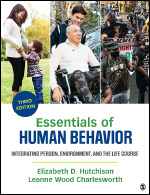Case Studies
Preface
Note from the Editors
Acknowledgments
About the Editors
About the Contributors
Part I . A Multidimensional, Multitheoretical Approach for Multifaceted Social Work
Chapter 1 . Human Behavior: A Multidimensional Approach
Human Behavior: Individual and Collective
A Multidimensional Approach
Diversity, Inequality, and the Pursuit of Social Justice: A Global Perspective
Scientific Knowledge: Theory and Research
Implications for Social Work Practice
Chapter 2 . Theoretical Perspectives on Human Behavior
Multiple Perspectives for a Multidimensional Approach
Exchange and Choice Perspective
Social Constructionist Perspective
Psychodynamic Perspective
Developmental Perspective
The Merits of Multiple Perspectives
Implications for Social Work Practice
Part II . The Multiple Dimensions of the Person
Chapter 3 . The Biological Person
An Integrative Approach for Understanding the Intersection of Interior Biological Health and Illness and Exterior Environmental Factors
Systems Taxonomy: Six Interior Environment Systems
Ecobiodevelopmental Framework to Understand the Relationship Between Interior Health and Exterior Environments
Implications for Social Work Practice
Chapter 4 . The Psychological Person
The Self in Relationships
Normal and Abnormal Coping
Implications for Social Work Practice
Chapter 5 . The Spiritual Person
Theories of Spiritual Development
The Role of Spirituality in Social Work
Implications for Social Work Practice
Part III . The Multiple Dimensions of the Environment
Chapter 6 . Cultures and the Physical Environment
Major Concepts in the Study of Culture
The Relationship Between the Physical Environment and Human Behavior
Accessible Environments for Persons With Disabilities
Implications for Social Work Practice
Chapter 7 . Families
The Family in Historical Perspective
Theoretical Perspectives for Understanding Families
Challenges to Family Life
Implications for Social Work Practice
Chapter 8 . Small Groups, Formal Organizations, and Communities
Small Groups in Social Work
Small Group Structure, Composition, and Processes
Theories of Group Processes
Formal Organizations: Definition and Theoretical Perspectives
Community: Territorial and Relational
Theoretical Approaches to Community
Implications for Social Work Practice
Chapter 9 . Social Structure, Social Institutions, and Social Movements: Global and National
Contemporary Trends in Global and U.S. Social Institutions
Theories of Social Inequality
Social Movements: Definition and Theoretical Perspectives
Implications for Social Work Practice
Part IV . The Changing Life Course
Chapter 10 . The Human Life Journey: A Life Course Perspective
The Life Course Perspective
Theoretical Roots of the Life Course Perspective
Basic Concepts of the Life Course Perspective
Major Themes of the Life Course Perspective
Life Course Developmental Perspective on Families
The Life Course Perspective and Social Work Practice
Integration With a Multidimensional, Multitheoretical Approach
Implications for Social Work Practice
Chapter 11 . The Journey Begins: Conception, Pregnancy, Childbirth, and Infancy
Sociocultural Organization of Childbearing and Child-Rearing
Control Over Conception and Pregnancy
Typical Infant Development
Childcare Arrangements in Infancy
Infants in the Multigenerational Family
Risk and Protective Factors in Conception, Pregnancy, Childbirth, and Infancy
Implications for Social Work Practice
Chapter 12 . Toddlerhood and Early Childhood
Typical Development in Toddlerhood and Early Childhood
Developmental Delays and Disabilities
Early Childhood Education
Toddlerhood and Early Childhood in the Multigenerational Family
Risks to Healthy Development in Toddlerhood and Early Childhood
Protective Factors in Toddlerhood and Early Childhood
Implications for Social Work Practice
Chapter 13 • Middle Childhood
Historical Perspective on Middle Childhood
Middle Childhood in the Multigenerational Family
Development in Middle Childhood
Middle Childhood and Formal Schooling
Special Challenges in Middle Childhood
Risk Factors and Protective Factors in Middle Childhood
Implications for Social Work Practice
Chapter 14 . Adolescence
The Social Construction of Adolescence Across Time and Space
The Transition From Childhood to Adulthood
Biological Aspects of Adolescence
Psychological Aspects of Adolescence
Social Aspects of Adolescence
Adolescent Spirituality/Religiosity
Potential Challenges to Adolescent Development
Risk Factors and Protective Factors in Adolescence
Implications for Social Work Practice
Chapter 15 . Young and Middle Adulthood
Theoretical Approaches to Adulthood
Physical Functioning in Young and Middle Adulthood
Cognition in Young and Middle Adulthood
Personality and Identity in Young and Middle Adulthood
Young- and Middle-Adult Spirituality
Relationships in Young and Middle Adulthood
Work in Young and Middle Adulthood
Risk Factors and Protective Factors in Young and Middle Adulthood
Implications for Social Work Practice
Chapter 16 . Late Adulthood
Demographics of the Older-Adult Population
Cultural Construction of Late Adulthood
Psychosocial Theoretical Perspectives on Social Gerontology
Biological Changes in Late Adulthood
Psychological Changes in Late Adulthood
Social Role Transitions and Life Events of Late Adulthood
The Search for Personal Meaning
Resources for Meeting the Needs of Elderly Persons
Loss, Grief, and Bereavement
Risk Factors and Protective Factors in Late Adulthood
The Life Course Completed
Implications for Social Work Practice
Glossary
References
Index


 Sage College Publishing
Sage College Publishing
